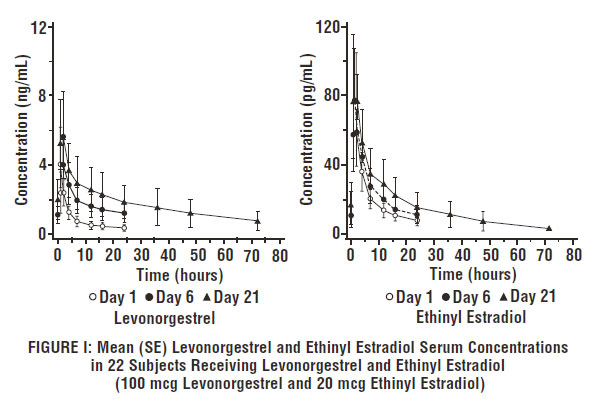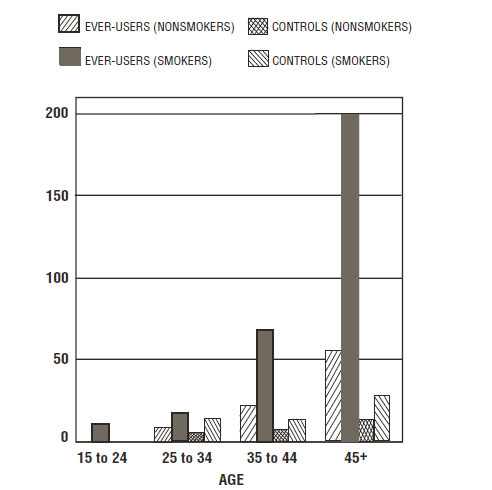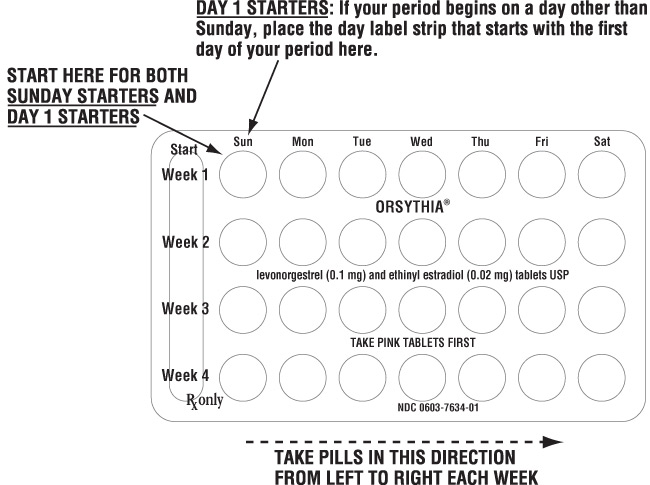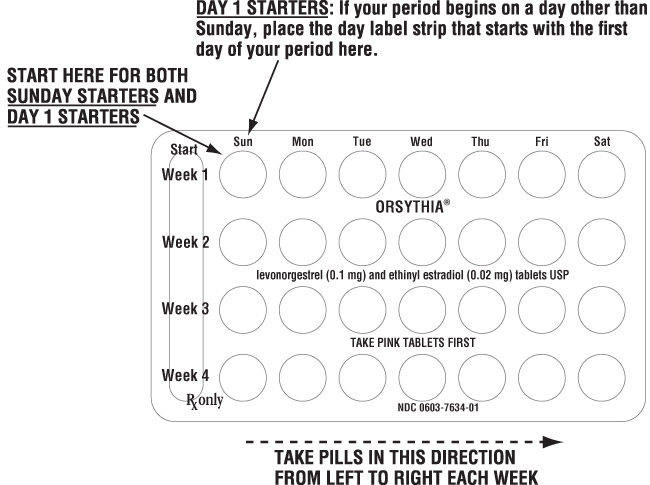Drug Catalog - Product Detail
LEVONORGESTREL/ETHINYL ESTRADIOL (ORSYTHIA) TB .10/.02MG 6X28
| NDC | Mfr | Size | Str | Form |
|---|---|---|---|---|
| 00603-7634-17 | PAR PHARMACEUTICALS | 28 | 0.1-20MG-MCG | TABLET |
PACKAGE FILES






Generic Name
Substance Name
Product Type
Route
Application Number
Description
DESCRIPTION 21 pink active tablets each containing 0.1 mg of levonorgestrel, d(-)-13β-ethyl-17α-ethinyl-17β-hydroxygon-4-en-3-one, a totally synthetic progestogen, and 0.02 mg of ethinyl estradiol, 17α-ethinyl-1,3,5(10)-estratriene-3, 17β-diol. The inactive ingredients present are FD&C red #40 aluminum lake, hypromellose, lactose monohydrate, magnesium stearate, microcrystalline cellulose, polyethylene glycol, pregelatinized starch and vitamin E. 7 light-green inert tablets, each containing FD&C blue #2, hypromellose, iron oxide yellow, lactose monohydrate, magnesium stearate, polyethylene glycol and pregelatinized starch. This is the chemical image of Levonorgestrel and Ethinyl Estradiol.
How Supplied
HOW SUPPLIED ORSYTHIA ® (levonorgestrel (0.1 mg) and ethinyl estradiol (0.02 mg) tablets USP) is packaged in cartons of 3 and 6 blister pack tablet dispensers. Each blister pack tablet dispenser contains 28 tablets as follows: 21 active tablets, pink, round, film-coated tablet debossed with "93" on one side and "684" on the other side. 7 inert tablets, light-green, round, film-coated tablet debossed with "93" on one side and "743" on the other side. Blister pack tablet dispenser NDC 0603-7634-01 Boxes of 3 blister pack tablet dispensers NDC 0603-7634-49 Boxes of 6 blister pack tablet dispensers NDC 0603-7634-17 Store at 20° to 25°C (68° to 77°F) [See USP Controlled Room Temperature]. References available upon request.
Indications & Usage
INDICATIONS AND USAGE ORSYTHIA ® (levonorgestrel and ethinyl estradiol tablets USP) is indicated for the prevention of pregnancy in women who elect to use oral contraceptives as a method of contraception. Oral contraceptives are highly effective. TABLE II lists the typical accidental pregnancy rates for users of combination oral contraceptives and other methods of contraception. The efficacy of these contraceptive methods, except sterilization, the IUD, and levonorgestrel implants, depends upon the reliability with which they are used. Correct and consistent use of methods can result in lower failure rates. TABLE II: Percentage of Women Experiencing an Unintended Pregnancy During the First Year of Typical Use and the First Year of Perfect Use of Contraception and the Percentage Continuing Use at the End of the First Year. United States. % of Women Experiencing an Unintended Pregnancy Within the First Year of Use % of Women Continuing Use at One Year 3 Method (1) Typical Use 1 (2) Perfect Use 2 (3) (4) Chance 4 85 85 Spermicides 5 26 6 40 Periodic abstinence 25 63 Calendar 9 Ovulation Method 3 Sympto-Thermal 6 2 Post-Ovulation 1 Cap 7 Parous Women 40 26 42 Nulliparous Women 20 9 56 Sponge Parous Women 40 20 42 Nulliparous Women 20 9 56 Diaphragm 7 20 6 56 Withdrawal 19 4 Condom 8 Female (Reality) 21 5 56 Male 14 3 61 Pill 5 71 Progestin only 0.5 Combined 0.1 IUD Progesterone T 2.0 1.5 81 Copper T380A 0.8 0.6 78 LNg 20 0.1 0.1 81 Injectable Progestogen 0.3 0.3 70 Levonorgestrel Implants 0.05 0.05 88 Female Sterilization 0.5 0.5 100 Male Sterilization 0.15 0.10 100 Emergency Contraceptive Pills: The FDA has concluded that certain combined oral contraceptives containing ethinyl estradiol and norgestrel or levonorgestrel are safe and effective for use as postcoital emergency contraception. Treatment initiated within 72 hours after unprotected intercourse reduces the risk of pregnancy by at least 75%. 9 Lactation Amenorrhea Method: LAM is a highly effective, temporary method of contraception. 10 Source: Trussell J. Contraceptive efficacy. In: Hatcher RA, Trussell J, Stewart F, Cates W, Stewart GK, Kowel D, Guest F. Contraceptive Technology: Seventeenth Revised Edition. New York NY: Irvington Publishers; 1998. 1 Among typical couples who initiate use of a method (not necessarily for the first time), the percentage who experience an accidental pregnancy during the first year if they do not stop use for any other reason. 2 Among couples who initiate use of a method (not necessarily for the first time) and who use it perfectly (both consistently and correctly), the percentage who experience an accidental pregnancy during the first year if they do not stop use for any other reason. 3 Among couples attempting to avoid pregnancy, the percentage who continue to use a method for one year. 4 The percents becoming pregnant in columns (2) and (3) are based on data from populations where contraception is not used and from women who cease using contraception in order to become pregnant. Among such populations, about 89% become pregnant within one year. This estimate was lowered slightly (to 85%) to represent the percent who would become pregnant within one year among women now relying on reversible methods of contraception if they abandoned contraception altogether. 5 Foams, creams, gels, vaginal suppositories, and vaginal film. 6 Cervical mucus (ovulation) method supplemented by calendar in the pre-ovulatory and basal body temperature in the post-ovulatory phases. 7 With spermicidal cream or jelly. 8 Without spermicides. 9 The treatment schedule is one dose within 72 hours after unprotected intercourse, and a second dose 12 hours after the first dose. The FDA has declared the following dosage regimens of oral contraceptives to be safe and effective for emergency contraception: for tablets containing 50 mcg of ethinyl estradiol and 500 mcg of norgestrel 1 dose is 2 tablets; for tablets containing 20 mcg of ethinyl estradiol and 100 mcg of levonorgestrel 1 dose is 5 tablets; for tablets containing 30 mcg of ethinyl estradiol and 150 mcg of levonorgestrel 1 dose is 4 tablets. 10 However, to maintain effective protection against pregnancy, another method of contraception must be used as soon as menstruation resumes, the frequency or duration of breastfeeds is reduced, bottle feeds are introduced, or the baby reaches 6 months of age. In a clinical trial with levonorgestrel and ethinyl estradiol tablets, 1,477 subjects had 7,720 cycles of use and a total of 5 pregnancies were reported. This represents an overall pregnancy rate of 0.84 per 100 woman-years. This rate includes patients who did not take the drug correctly. One or more pills were missed during 1,479 (18.8%) of the 7,870 cycles; thus all tablets were taken during 6,391 (81.2%) of the 7,870 cycles. Of the total 7,870 cycles, a total of 150 cycles were excluded from the calculation of the Pearl index due to the use of back-up contraception and/or missing 3 or more consecutive pills.
Dosage and Administration
DOSAGE AND ADMINISTRATION To achieve maximum contraceptive effectiveness, ORSYTHIA ® (levonorgestrel and ethinyl estradiol tablets USP) must be taken exactly as directed and at intervals not exceeding 24 hours. The dosage of ORSYTHIA ® (levonorgestrel and ethinyl estradiol tablets USP) is one pink tablet daily for 21 consecutive days, followed by one light-green inert tablet daily for 7 consecutive days, according to the prescribed schedule. It is recommended that ORSYTHIA ® (levonorgestrel and ethinyl estradiol tablets USP) be taken at the same time each day. The dispenser should be kept in the wallet supplied to avoid possible fading of the pills. If the pills fade, patients should continue to take them as directed. During the First Cycle of Use The possibility of ovulation and conception prior to initiation of medication should be considered. The patient should be instructed to begin taking ORSYTHIA ® (levonorgestrel and ethinyl estradiol tablets USP) on either the first Sunday after the onset of menstruation (Sunday Start) or on Day 1 of menstruation (Day 1 Start). Sunday Start The patient is instructed to begin taking ORSYTHIA ® (levonorgestrel and ethinyl estradiol tablets USP) on the first Sunday after the onset of menstruation. If menstruation begins on a Sunday, the first tablet (pink) is taken that day. One pink tablet should be taken daily for 21 consecutive days, followed by one light-green inert tablet daily for 7 consecutive days. Withdrawal bleeding should usually occur within 3 days following discontinuation of pink tablets and may not have finished before the next pack is started. During the first cycle, contraceptive reliance should not be placed on ORSYTHIA ® (levonorgestrel and ethinyl estradiol tablets USP) until a pink tablet has been taken daily for 7 consecutive days, and a nonhormonal back-up method of birth control should be used during those 7 days. Day 1 Start During the first cycle of medication, the patient is instructed to begin taking ORSYTHIA ® (levonorgestrel and ethinyl estradiol tablets USP) during the first 24 hours of her period (day one of her menstrual cycle). One pink tablet should be taken daily for 21 consecutive days, followed by one light-green inert tablet daily for 7 consecutive days. Withdrawal bleeding should usually occur within 3 days following discontinuation of pink tablets and may not have finished before the next pack is started. If medication is begun on day one of the menstrual cycle, no back-up contraception is necessary. If ORSYTHIA ® (levonorgestrel and ethinyl estradiol tablets USP) is started later than day one of the first menstrual cycle or postpartum, contraceptive reliance should not be placed on ORSYTHIA ® (levonorgestrel and ethinyl estradiol tablets USP) until after the first 7 consecutive days of administration, and a nonhormonal back-up method of birth control should be used during those 7 days. After the First Cycle of Use The patient begins her next and all subsequent courses of tablets on the day after taking her last light-green tablet. She should follow the same dosing schedule: 21 days on pink tablets followed by 7 days on light-green tablets. If in any cycle the patient starts tablets later than the proper day, she should protect herself against pregnancy by using a nonhormonal back-up method of birth control until she has taken a pink tablet daily for 7 consecutive days. Switching From Another Hormonal Method of Contraception When the patient is switching from a 21 day regimen of tablets, she should wait 7 days after her last tablet before she starts ORSYTHIA ® (levonorgestrel and ethinyl estradiol tablets USP). She will probably experience withdrawal bleeding during that week. She should be sure that no more than 7 days pass after her previous 21 day regimen. When the patient is switching from a 28 day regimen of tablets, she should start her first pack of ORSYTHIA ® (levonorgestrel and ethinyl estradiol tablets USP) on the day after her last tablet. She should not wait any days between packs. The patient may switch any day from a progestin-only pill and should begin ORSYTHIA ® (levonorgestrel and ethinyl estradiol tablets USP) the next day. If switching from an implant or injection, the patient should start ORSYTHIA ® (levonorgestrel and ethinyl estradiol tablets USP) on the day of implant removal or, if using an injection, the day the next injection would be due. In switching from a progestin-only pill, injection, or implant, the patient should be advised to use a nonhormonal back-up method of birth control for the first 7 days of tablet-taking. If Spotting or Breakthrough Bleeding Occurs If spotting or breakthrough bleeding occur, the patient is instructed to continue on the same regimen. This type of bleeding is usually transient and without significance; however, if the bleeding is persistent or prolonged, the patient is advised to consult her physician. Risk of Pregnancy if Tablets are Missed While there is little likelihood of ovulation occurring if only one or two pink tablets are missed, the possibility of ovulation increases with each successive day that scheduled pink tablets are missed. Although the occurrence of pregnancy is unlikely if ORSYTHIA ® (levonorgestrel and ethinyl estradiol tablets USP) is taken according to directions, if withdrawal bleeding does not occur, the possibility of pregnancy must be considered. If the patient has not adhered to the prescribed schedule (missed one or more tablets or started taking them on a day later than she should have), the probability of pregnancy should be considered at the time of the first missed period and appropriate diagnostic measures taken. If the patient has adhered to the prescribed regimen and misses two consecutive periods, pregnancy should be ruled out. The risk of pregnancy increases with each active (pink) tablet missed. For additional patient instructions regarding missed tablets, see the WHAT TO DO IF YOU MISS PILLS in the DETAILED PATIENT LABELING below. Use After Pregnancy, Abortion or Miscarriage ORSYTHIA ® (levonorgestrel and ethinyl estradiol tablets USP) may be initiated no earlier than day 28 postpartum in the nonlactating mother or after a second trimester abortion due to the increased risk for thromboembolism (see CONTRAINDICATIONS , WARNINGS , and PRECAUTIONS concerning thromboembolic disease). The patient should be advised to use a non-hormonal back-up method for the first 7 days of tablet taking. ORSYTHIA ® (levonorgestrel and ethinyl estradiol tablets USP) may be initiated immediately after a first trimester abortion or miscarriage. If the patient starts ORSYTHIA ® (levonorgestrel and ethinyl estradiol tablets USP) immediately, back-up contraception is not needed.
